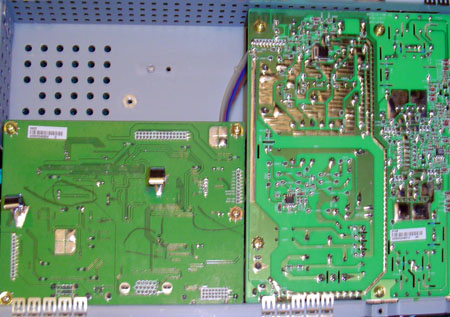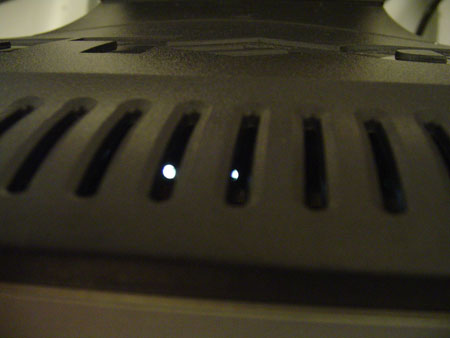Dell UltraSharp 1905FP: Setting the Bar for New 19" LCDs
by Kristopher Kubicki on January 29, 2005 12:35 AM EST- Posted in
- Displays
Construction (continued)
In fact, the only major change that occurred to the aesthetics of the monitor is on the height adjustment stand. The stand looks very similar to the original one, but it looks like Dell ditched the rounded design for a slightly different structure. The universal joint on the back actually pivots much easier than the one on our 2001FP, a plus for the 1905FP thus far.
Dell completely redesigned the cable management in the rear, but in our opinion, plastic housing isn't much of an improvement over the previous attempt (which we didn't find very useful either). The monitor still features a quick release for a VESA wall mount. You can also see a button that activates the vertical height adjustment in the picture above.

Dell 1905FP inputs
Click to enlarge.
From the inputs above, you can see that Dell ditched the brick power supply. The 1905FP houses the AC to DC inverter inside the rear panel and hooks up using a standard three-prong 120V AC cable. For comparison, we included a snapshot of the Dell 2001FP input set below.

Dell 2001FP inputs
Click to enlarge.
After a few hours of operation, we recorded the air temperature near the exhausts of the LCD around 28 degrees Celsius with an ambient air temperature of 23 degrees Celsius. This is several degrees cooler than some of the other monitors that we have in the lab, like the Dell 2001FP and NuTech L921G.
Bleeding Light
Several of our forum members are fairly upset about UltraSharp 2005FPW models that have intermittent backlight problems. With this subject in mind, we paid extra attention to backlight issues in case there might be problems on the 1905FP as well. While we did not detect any problems on our panel (screen uniformity was perfect), we did notice that we could actually see the backlights from outside the monitor!
In the image above, you can see the light of the backlights reflecting off something metal. We could not detect the light without looking carefully into the monitor. The obvious problem here is that the electrical components and backlights are exposed to the elements - even if that might be an office environment. If dust settles on the backlights, we could have a big problem with screen uniformity and brightness. Remember the Samsung 193P that uses the same panel? When we tested that LCD, we thought it was innovative that the monitor completely enclosed the LCD panel without any openings. In retrospect, Samsung's decision to do that might have been more function than form.
Opening it Up
After benchmarking this monitor, we opened it up to get a more in-depth look at the individual apparatus. Doing this will certainly void your warranty.

Separating the electronic components from the panel, we can see the underside of the digital/analog PCB on the left and the power inverters on the right. The entire electrical packaging behind the panel is less than an inch thick, which is impressive considering that inverters typically take up bulkier packaging - we refer to power bricks as "bricks" for a reason. We have always applauded integrated inverters in LCDs because they are more efficient. When we have external inverters leading to the monitor, the DC must be modulated and inverted back to AC for the florescent backlights.












66 Comments
View All Comments
Amol - Saturday, January 29, 2005 - link
and WHEN is the 2005FPw going to get reviewed? actually, nvm, i already got it :)JoKeRr - Saturday, January 29, 2005 - link
always LOVES Anandtech's review on LCDs, definitely the best reviews out there. So I guess response time isn't everything in the end.and what's up with the backlite problem? how do u detect that??
archcommus87 - Saturday, January 29, 2005 - link
1280x1028? Last page...Great article.
phaxmohdem - Saturday, January 29, 2005 - link
Time to upgrade my dual 17inch video editing setup! Sweet!*cough* first post! :)
igr11 - Saturday, September 3, 2005 - link
Excellent article. I own the Dell UltraSharp 1905FP and I find few faults with the monitor. I was wondering if it is possible to post your Colorvision calibrated profiles (the ones you used in the article). I dabble in image editing, but can't afford a decent hardware profiling system.Thanks,
Igor
rufwork - Tuesday, October 21, 2014 - link
"We noticed poorer than typical results when using the analog 15-pin D-sub connector with extremely bad streaking/interference errors. There isn't a large reason to use analog in our opinion, so this is not a huge issue in the long run. The DVI signal quality was superb, as expected on a digital connection."I'm stuck with this thing at work, nearly literally salvaged from the scrap heap to hook up to my hand-me-down laptop that sports a VGA out and a really poor 1366x768 resolution that makes the Ancient One an improvement.
Hilarious reading through the gushing for what must have been a very solid square (!!) monitor -- over nine years ago -- and to see that Anandtech figured nobody'd see the limitations of analog use "in the long run", just like I'm using it now in 2014. Maybe I'll watch the Matrix too for old time's sake^H^H^H to push the 1905FP to its limits. ;^)